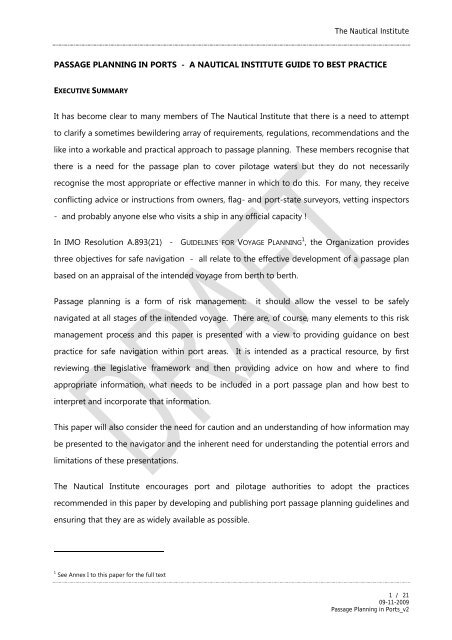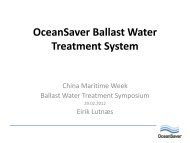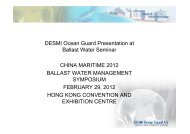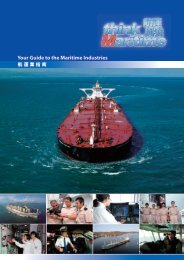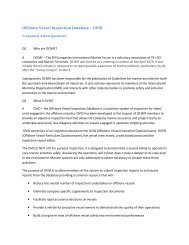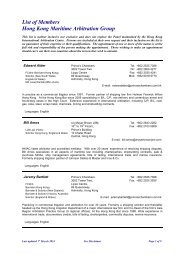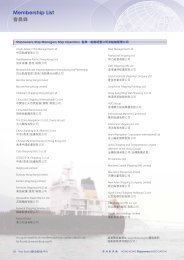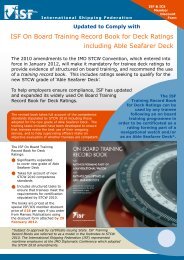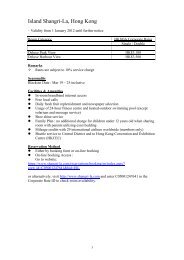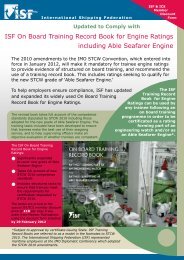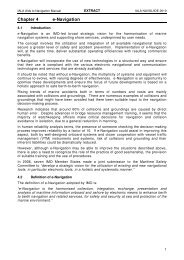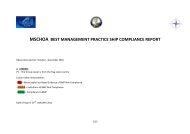PASSAGE PLANNING IN PORTS - A NAUTICAL INSTITUTE GUIDE ...
PASSAGE PLANNING IN PORTS - A NAUTICAL INSTITUTE GUIDE ...
PASSAGE PLANNING IN PORTS - A NAUTICAL INSTITUTE GUIDE ...
You also want an ePaper? Increase the reach of your titles
YUMPU automatically turns print PDFs into web optimized ePapers that Google loves.
The Nautical Institute<strong>PASSAGE</strong> <strong>PLANN<strong>IN</strong>G</strong> <strong>IN</strong> <strong>PORTS</strong> - A <strong>NAUTICAL</strong> <strong>IN</strong>STITUTE <strong>GUIDE</strong> TO BEST PRACTICEEXECUTIVE SUMMARYIt has become clear to many members of The Nautical Institute that there is a need to attemptto clarify a sometimes bewildering array of requirements, regulations, recommendations and thelike into a workable and practical approach to passage planning. These members recognise thatthere is a need for the passage plan to cover pilotage waters but they do not necessarilyrecognise the most appropriate or effective manner in which to do this. For many, they receiveconflicting advice or instructions from owners, flag- and port-state surveyors, vetting inspectors- and probably anyone else who visits a ship in any official capacity !In IMO Resolution A.893(21) - <strong>GUIDE</strong>L<strong>IN</strong>ES FOR VOYAGE <strong>PLANN<strong>IN</strong>G</strong> 1 , the Organization providesthree objectives for safe navigation - all relate to the effective development of a passage planbased on an appraisal of the intended voyage from berth to berth.Passage planning is a form of risk management: it should allow the vessel to be safelynavigated at all stages of the intended voyage. There are, of course, many elements to this riskmanagement process and this paper is presented with a view to providing guidance on bestpractice for safe navigation within port areas. It is intended as a practical resource, by firstreviewing the legislative framework and then providing advice on how and where to findappropriate information, what needs to be included in a port passage plan and how best tointerpret and incorporate that information.This paper will also consider the need for caution and an understanding of how information maybe presented to the navigator and the inherent need for understanding the potential errors andlimitations of these presentations.The Nautical Institute encourages port and pilotage authorities to adopt the practicesrecommended in this paper by developing and publishing port passage planning guidelines andensuring that they are as widely available as possible.1See Annex I to this paper for the full text1 / 2109-11-2009Passage Planning in Ports_v2
The Nautical Institute<strong>IN</strong>TRODUCTIONIf you take a close look at a world map of shipping, you will find that the majority of major portsof the world are not on the coast of their respective countries. For the most part, they are, infact, some considerable distance inland - or, at least, sheltered from the open waters of theoceans by long estuarial rivers or by complex archipelagos of island and rocky inlets. Yet,through the centuries and despite the restrictions of access, they have all developed as centresof world trade.Our ‘navigator forefathers’ all managed to find their way from one of these ports to anotherwithout reliance on GPS, radar, VTS, electronic chart systems or any of the other aids tonavigation that we take for granted in the 21 st Century. Not all of them made it safely, of course,but world trade developed in large part thanks to their skills and knowledge.NAVIGATION AND RISK MANAGEMENTThe shipping industry, by its very nature, has always been and still is a highly risky business: it isnot 100% accident or incident free. To reduce navigational accidents, incidents and consequentclaims, there is a need for the adoption of formal, risk-based management techniques.Of course, the early navigators took many risks, both commercially and geographically, topromote the development of world trade - would you now consider taking a three-mastedbarque to the other side of the world to sell a cargo of fine cloth and fine wines, for example,with only the most rudimentary knowledge of navigation, weather systems, ocean currents,depths of water, customs and practices in foreign ports ?I would venture to suggest that theanswer is probably “No !”2 / 2109-11-2009Passage Planning in Ports_v2
The Nautical InstitutePassage planning is a form of risk management: it should allow the vessel to be safelynavigated at all stages of the intended voyage. In order to do so, it is essential that there is anappropriate mechanism within the ship’s Safety Management System to ensure that any and allplans are not only assessed prior to their implementation but also that they are effectivelymonitored throughout the voyage. It is also essential that the ship’s SMS has a clear andunequivocal statement that the passage plan is an indication of intention: that the passage planis a dynamic tool and that it can and must be updated as necessary to take account of changingcircumstances and conditions.As a part of the passage planning process, the navigator should take into account not only therelative safety of deep water navigation but also the constraints and restraints associated withnavigating in confined waters. He should identify areas where there are levels of greater riskand he should consult with the Master before committing the vessel to the passage plan. TheMaster should have the final approval.THE REGULATORY FRAMEWORKSOLAS Chapter V, Regulation 34 requires1. Prior to proceeding to sea, the master shall ensure that the intended voyage hasbeen planned using the appropriate nautical charts and nautical publications forthe area concerned, taking into account the guidelines and recommendationsdeveloped by the Organization.*2. The voyage plan shall identify a route which:2.1 takes into account any relevant ships' routeing systems2.2 ensures sufficient sea room for the safe passage of the ship throughout thevoyage2.3 anticipates all known navigational hazards and adverse weather conditions;and2.4 takes into account the marine environmental protection measures that apply,and avoids, as far as possible, actions and activities which could cause damage tothe environment3 / 2109-11-2009Passage Planning in Ports_v2
The Nautical Institute3. The owner, the charterer, or the company, as defined in regulation IX/1,operating the ship or any other person shall not prevent or restrict the master of theship from taking or executing any decision which, in the master's professionaljudgement, is necessary for safe navigation and protection of the marineenvironment.* The “guidelines and recommendations developed by the Organization” are contained in IMOResolution A.893(21) - <strong>GUIDE</strong>L<strong>IN</strong>ES FOR VOYAGE <strong>PLANN<strong>IN</strong>G</strong>, which states that“3.) Planning3.1) On the basis of the fullest possible appraisal, a detailed voyage or passage planshould be prepared which should cover the entire voyage or passage from berth toberth 2 , including those areas where the services of a pilot will be used. …”With respect to Port Passage Planning, the IMO has considered this within Resolution A.960(23)- “RECOMMENDATIONS ON TRA<strong>IN</strong><strong>IN</strong>G AND CERTIFICATION AND OPERATIONAL PROCEDURES FOR MARITIMEPILOTS OTHER THAN DEEP-SEA PILOTS”.This will be further considered later in the paper whenlooking at the Master / Pilot Exchange.Within the UK, the [now] Department for Transport has published the Port Marine Safety Code[PMSC]. For UK port authorities, compliance with its recommendations is mandatory and,although few other countries have adopted similar framework documents, PMSC is increasinglybeing seen as the basis for best practices in ports world-wide. §2.4 of the PMSC deals with theRegulation and Management of Navigation. This is reproduced, in part, at Annex II to thispaper.2Bold text inserted for emphasis4 / 2109-11-2009Passage Planning in Ports_v2
The Nautical InstituteThe recommendations of PMSC make logical sense and reinforce the concept that a passageplan is, in effect, a formal documentation of a risk assessment exercise. The passage plan shouldidentify the relevant navigation and safety skills that will need to be exercised by the bridgeteam throughout the intended passage, as well as the measures that will be needed to mitigateany risks associated with the passage plan. It must identify the areas where it is expected that apilot will be on board to assist with the safe conduct of the vessel to its berth – or through acomplex navigational area [e.g., Suez or Panama Canals]. The bridge team must be briefed toensure that they do not and must not relax their vigilance during this period.The pilot is, after all, a navigator by profession [like us all] but with the added advantage of localknowledge. The pilot is there to provide advice: he legally has the conduct of the vessel whilstthe Master remains in command, retaining the overall responsibility for the safety of the vessel,which includes the effectiveness of the Bridge team. It is essential to ensure that the pilotbecomes an integral and welcome part of the Bridge team and that he is not left unsupported inhis role.GATHER<strong>IN</strong>G <strong>IN</strong>FORMATION - “APPRAISAL”It should be remembered, of course, that the port passage plan is not a separate document - itis an integral part of the passage plan from berth to berth. The requirements for safe navigationwithin port areas remain the same as they do for deep water navigation. The principaldifference is that it is probable that the risks to safe navigation are inherently higher when in therestricted waters normally associated with port and pilotage waters.In IMO Resolution A.893(21), the Organization provides comprehensive generic passageplanning guidance. Inter alia, it clearly states2.) Appraisal2.1) All information relevant to the contemplated voyage or passage should beconsidered. … 33IMO Res. A.893(21), Annex 25 / 2109-11-2009Passage Planning in Ports_v2
The Nautical InstituteWhere, then, does the navigator find the information that he needs to make a safe port passageplan?There is a need for the navigator to ensure that he has considered all of the safety criteria whichwill include, but are not limited to:minimum under keel clearance throughout, making allowance as necessary fortidal influences;the ability to maintain a safe speed; alteration of course positions, taking into account the manoeuvringcharacteristics of the vessel;the use of appropriate routeing systems;environmental restrictions, if any; andidentification of contingency plans to take account of abort points, anchorages,pilot embarkation positions, etc.It is also desirable that the passage plan should consider the requirements and restrictionsassociated with the berthing or unberthing of the ship. Which berth are we going to / from ?What tugs are available ? do we need tugs ? what tidal restrictions will apply ? and so on.In considering the list above, most of the information is already on board the ship since it relatesto the manoeuvrability of the ship. It will be in use on a daily basis and will probably be in thenavigator’s mind at all times. However, some of that information will be port specific and therewill be a need to find this information from a variety of sources.The primary source of information for the port specific elements of the passage plan will be byreference to the appropriate charts for port entry. These will provide the navigator with anoverall indication of where the ship is likely to go, although for large ports with many terminals,this may not be so clear.The navigator will also make reference to the appropriate sailing directions or pilot books, theAdmiralty List of Radio Signals – particularly with reference to pilot boarding positions andcontact information - as well as to local reference documents that may be provided.6 / 2109-11-2009Passage Planning in Ports_v2
The Nautical InstituteFor relatively short passages, the navigator will be able to provide an accurate indication of tidalconditions at the intended ports. For long passages, this may not be possible in detail but heshould, nonetheless, provide an indication of tidal restraints, if any, at the destination port.It is to be encouraged, of course, that the navigator should have access to the internet and,therefore, to a port authority’s web-site. The UK PMSC requires that ports provide passageplanning guidance as a part of their own Safety Management Systems.The Nautical Institute encourages all port authorities to provide appropriate and significant portpassage planning guidance on their web-sites.Two good examples of this practice are the Port of Rotterdam and the Ports of Melbourne,Geelong and Westernport in Australia.The Port of Rotterdam publishes its Port Information Guide 4- in .pdf format fordownload - which contains very comprehensive details of approach channels, pilotagerequirements and much more.For the Australian ports mentioned above, the Passage Planning solution (from acommercial provider) facilitates the public demonstration and clarity of purpose of pilotservice providers to their customers, suppliers, employees and the communities inwhich they operate. The solution achieves this through publishing the standardoperating procedures and all aspects of passage planning on the Internet therebyfacilitating communication and understanding with all interested parties. 5VOYAGE <strong>PLANN<strong>IN</strong>G</strong>In practice every berth to berth passage consists of the following three key elements:Port departure4http://www.portofrotterdam.com/en/shipping/seashipping/index.jsp /http://www.portofrotterdam.com/mmfiles/port_information_guide_tcm26-51823.pdf5http://www.ecomaritime.com/Demonstration/About.html7 / 2109-11-2009Passage Planning in Ports_v2
The Nautical InstituteThe voyageDestination port arrivalEach of these stages will be affected by static and dynamic elements and cannot be fixed in thesame way as an aircraft’s flight plan. The static elements are such things as the physicaldimensions of the ship, draft, air draft, manoeuvring characteristics and cargo. The dynamicelements will consist of such elements as weather, tides, berth availability etc.Much of the dynamic element affecting the passage plan will be port specific and some portsmay have established under keel clearance (UKC) parameters which may differ from the ship’srecommended guidelines and these should be verified prior to arrival. Actual anticipated UKCbased on the latest data should be confirmed during the Master / pilot exchange - see below.In open waters, it is probable that alteration of course positions will be determined by referenceto lights or prominent coastal features and the position will be approximately at the intersectionof the appropriate tracks.In port waters, however, the scale of the charts available will provide a more detailed indicationof the ship’s intended track. It is quite probable that there will be a need to determine a wheeloverposition [WOP] at some distance from the intersection of the two track lines to ensure thatthe ship will achieve the intended track.Planned WOPs should be determined from the ship’s manoeuvring data and marked on theappropriate chart or charts. It may be appropriate to consider the use of parallel indextechniques to determine this position.In tankers, for example, where the passage is based on a vague instruction of a nominated port“for orders”, it will be difficult to for the navigator to develop a full berth to berth passage plan.However, when the load or discharge port is confirmed, the process of passage planningremains the same. He will then have a better indication of ETA and can make appropriatecalculations with respect to tides, particularly where there may be tidal influences on theprogress of the voyage.8 / 2109-11-2009Passage Planning in Ports_v2
The Nautical InstituteWhen the navigator has gathered all the required information and created his passage plan, asnoted above, he should present this to the master for his approval. It is not sufficient that thepassage plan is presented solely on the charts for the intended voyage. He should provideinformation on tidal conditions, pilotage practices, recommendations on the frequency ofmonitoring the ship’s position at various stages of the voyage and so on.In many instances, the ship’s SMS will require this to be so and may provide a format for thepresentation of passage plans. The SMS may also require that all passage plans are forwardedto ‘the office’ for record keeping purposes.VOYAGE PLAN EXECUTIONIt is important to remember, however, that even after approval of the passage plan by themaster and its submission to the office, the passage plan is a dynamic plan - it should not beconsidered to be “set in stone”. The passage plan is subject to change and deviation. Tidaland/or weather conditions may necessitate a deviation from the plan, as will a change of orders.The arrival on board of the pilot may also create a deviation from the approved passage plan.The pilot has a greater knowledge of the port and its approaches and, in almost all cases, willhave knowledge of the intended berth, its availability, restrictions and the like. The passage planmay anticipate a particular route into the port but the pilot may advise otherwise.THE MASTER / PILOT EXCHANGEIt is probable that, for a number of masters, navigators and pilots, this is seen as a frustratingbut necessary element of the voyage. There has been much correspondence in SEAWAYS onthis matter and this paper will not revive those issues.Within IMO Resolution A.960(23), it states that5.1 The Master and the pilot should exchange information regardingnavigational procedures, local conditions and the ship’s characteristics. Thisinformation exchange should be a continuous process that generally continues forthe duration of the pilotage. …9 / 2109-11-2009Passage Planning in Ports_v2
The Nautical Institute5.4 This exchange of information should include at least:5.4.1 … pilot card …;5.4.2 General agreement on plans and procedures, includingcontingency plans, for the anticipated passage; …5.4.5 information on berthing arrangements; … tugs; …5.4.7 confirmation of the language to be used on the bridge and withexternal parties.5.5 It should be clearly understood that any passage plan is a basicindication of preferred intention and both the pilot and the master should beprepared to depart from it when circumstances so dictate. … 6With reference to 5.4.2, this general agreement should include a discussion on the pilot’splanned route, his anticipated speeds and ETAs at various points along the plan, under keelclearances, what assistance he expects from the shore and, significantly, what contingency planshe may have in the event that there need to be changes to the passage plan en route.The pilot’s local and current knowledge of the conditions in the port may have a profoundimplication on the execution of the passage plan and, therefore, the Master / Pilot exchange isan inherent part of the passage plan. The Master / Pilot exchange should include the OOW: if itdoes not, the Master should provide an early briefing to the Bridge team of any relevantinformation.It is desirable that the navigator has monitored and amended the passage plan throughout thevoyage so that, on arrival at the pilot station, it is thoroughly up-to-date. In the event that theMaster / Pilot exchange leads to an amendment of the passage plan, the changes required maybe minimal.As already noted, It is essential that the ship’s SMS has a clear and unequivocal statement thatthe passage plan is an indication of intention: that the passage plan is a dynamic tool and thatit can and must be updated as necessary to take account of changing circumstances andconditions. It may be appropriate to make reference to the Master / Pilot exchange in thisprocess.6My bold text for emphasis10 / 2109-11-2009Passage Planning in Ports_v2
The Nautical InstituteIf changes need to be made to the plan, it is desirable that they can be made as early aspossible. The ship will, of course, be in contact with the agents and pilots prior to arrival,providing details of ETA [and any changes to that], draught, etc. Therefore some of theelements of the Master / Pilot exchange may be available prior to embarkation of the pilot.All ships have a pilot card - some ships may have this in an electronic format - which must bepresented to the pilot upon his arrival on the bridge. In return the pilot should have prepared adetailed passage plan, which will give details of, for example, the approach channel to be usedalong with times and under keel clearances at the critical points based on the latest livehydrographic data. The execution of the passage plan can then be monitored effectively by thebridge team.The pilot card and the passage plan can be sent to the agents / pilots along with the initialcontact information. In this way, there can be an early exchange of updated local informationthat can be incorporated into the passage plan and given to the Bridge team prior toembarkation of the pilot. The Master / Pilot exchange then becomes a brief confirmation of thestatus of the ship and its equipment. The pilot’s intended port passage plan, including theadoption of any changes that have been previously agreed, can be rapidly confirmed by theBridge team.If this is not done, then changes identified during the Master / Pilot exchange need to beimplemented swiftly and safely. The SMS should identify that the navigator should be presentduring the Master / Pilot exchange and that that any changes are documented on the paperchart and that they are relayed to the Bridge team: the execution of the passage plan includesthe effective monitoring of the ship’s progress along the intended track. The Bridge teamcannot perform this function with inaccurate information.Once the pilotage passage commences, the Pilot should concentrate on conducting the vesselsafely to its berth with the Bridge team concentrating on monitoring the passage plan. TheDynamic element of the passage plan has already been mentioned as essential and it is duringthe pilotage passage that several factors, such as the late sailing of a vessel occupying theintended berth or other vessel movements, can result in the initial plan requiring amendment.11 / 2109-11-2009Passage Planning in Ports_v2
The Nautical InstituteIn pilotage waters, it is good practice to nominate one member of the Bridge Team to monitorthe passage plan. This should not be the Master - he should retain his overall situationalawareness, making use of the team around him. The OOW needs to monitor carefully the ship’sprogress and to bring to the attention of both the pilot and the Master any deviations from theintended track or speed. The OOW also needs to continue to monitor other shipping traffic inthe vicinity and to be aware of the probable intentions of other vessels and their potentialimpact or influence on the execution of the passage plan. The OOW needs to have theconfidence to speak to the master or to the pilot about any concerns he may have regarding theprogress or otherwise of the ship on the passage plan.It must be emphasised that the provision of sophisticated electronic navigation systems remainsan aid to navigation. In pilotage waters, in particular, the use of ECS / ECDIS / IBS takes onan additional significance: Pilots cannot be expected to be fully familiar and proficient inthe use of all systems currently available.Where pilots use their own PPU, the OOW mustbe aware that he must continue to monitor the ship’s progress using the ship’s navigationsystems and to continue to bring apparent deviations from the passage plan to the pilot’sattention.Even after the pilot has boarded and an agreed port passage plan has been adopted, trafficdensity or weather and tide conditions may dictate a further deviation. In these circumstances,quick thinking and swift action by the Bridge team may be required and it may not bepracticable or possible to document these changes. If so, the OOW should make a note in theBridge Movement Book of these changes. [The VDR will record these changes but a writtencontemporaneous note will not go amiss.]<strong>PASSAGE</strong> PLANS AND SHIP <strong>IN</strong>SPECTIONSMany ships are subject to frequent inspection and it is accepted that the ship’s passage plansare often subject to scrutiny. The inspectors will want to be satisfied that the ship has beensafely and effectively navigated: in all probability this will involve a comprehensive examinationof the charts and log books, with particular attention to the approved passage plan and theship’s compliance with that passage plan.13 / 2109-11-2009Passage Planning in Ports_v2
The Nautical InstituteA number of members of The Nautical Institute have reported that the non-conformities havebeen imposed on their ship as a result of a deviation from the passage plan.As we have already seen, IMO Resolution A.960 is quite clear:5.5 It should be clearly understood that any passage plan is a basicindication of preferred intention and both the pilot and the master should beprepared to depart from it when circumstances so dictate. …It is the opinion of The Nautical Institute that it is unreasonable to impose non-conformities fornavigational issues other than for blatant and flagrant breaches of regulations, in particular theCollision Regulations, or of the Company’s SMS. For example, a passage plan that takes a shipin the wrong direction of an established Traffic Separation Scheme is clearly such a case but Thefailure to plot the ship’s position on the paper chart once tugs have been engaged is not.Voyage Data Recorders provide navigational records and it may be appropriate to consider howa vetting inspector may be given access to the VDR, if necessary.CONCLUSIONSIn the Collision Regulations, it states quite clearly that “assumptions based on scanty informationmay be dangerous and should be avoided”. Although this relates to the conduct of vessels inrestricted visibility, it can be applied to any operation within the ship that requires carefulplanning and the effective management of risk. In order to develop and execute a safe andefficient passage plan, the navigator must be provided with as much relevant information aspossible.There is clearly a need for the marine industry to work together more closely and to be morefully aware of the demands of passage planning and passage monitoring on the ship and theBridge Team.14 / 2109-11-2009Passage Planning in Ports_v2
The Nautical InstituteOf course, to transport goods safely from one part of the world to another requires the mostcareful planning and execution of navigation but it can only be achieved in line with thecommercial demands of the ship in question. It is essential that the SMS for the ship and itsoperators not only addresses the needs of the risk management [passage planning] processesbut also that it adequately reflects the manning of the vessel and the demands on the manningof various activities, particularly those associated with the safe navigation of the vessel and thedelivery of the cargo.The Nautical Institute encourages port and pilotage authorities to adopt the practicesrecommended in this paper by developing and publishing port passage planning guidelines andensuring that they are as widely available as possible.15 / 2109-11-2009Passage Planning in Ports_v2
The Nautical InstituteANNEX I - IMO RESOLUTION A.893(21) - <strong>GUIDE</strong>L<strong>IN</strong>ES FOR VOYAGE <strong>PLANN<strong>IN</strong>G</strong>Insert in full16 / 2109-11-2009Passage Planning in Ports_v2
The Nautical InstituteANNEX II - THE PORT MAR<strong>IN</strong>E SAFETY CODEIt is, perhaps, worthwhile to quote extensively from this document and from its associated“Guide to Good Practice on Marine Operations”.2.4. Regulation and Management of Navigation2.4.1. This chapter is about the powers which harbour authorities have to makebyelaws and give directions. These powers give statutory force to requirements ofthe safety management systems developed under this Code. The use of thesepowers should follow these general principles:-A. Ports have rules in byelaws and directions, which every user must obey as acondition of his or her right to use the harbour.B. Harbour authorities have a duty to make proper use of powers to make byelaws,and to give directions (including pilotage directions), to regulate all vesselmovements in their waters.C. These powers should be exercised in support of the policies and proceduresdeveloped in the authority's safety management system, and should be used tomanage the navigation of all vessels.D. Harbour authorities should have clear policies on the enforcement of directions,and should monitor compliance.E. Powers of direction should be used to require the use of port passage plans inappropriate cases - whether vessels are piloted or not.Available powers2.4.2. There are four main powers available to a harbour authority to regulate shipmovements -• byelaws: provide a general framework for rules of navigation which applyto all vessels - including speed limits, defining fairways, anchorages, etc. -and which can be treated as unlikely to require frequent or short termamendment.• harbour directions - may be given by the harbour master: these directionsare time and vessel specific, and are most apt for operational purposes andfor emergencies. Some harbour authorities have more effective powers ofgeneral direction to be given by the authority itself. Directions shouldapply to all vessels, including where a vessel is conducted by a pilot or theholder of a pilotage exemption certificate.• pilotage directions - may generally be given by harbour authorities whichhave the power to regulate navigation: these determine the circumstancesin which pilotage is to be compulsory.• dangerous vessel directions - are a special case, permitting a harbourmaster to remove a vessel from the harbour in clearly definedcircumstances: they may be over-ruled by the Secretary of State.17 / 2109-11-2009Passage Planning in Ports_v2
The Nautical InstituteThe use of all these powers should be governed by the authority's formal riskassessment, and should support the safety management system. It is to be noted, inthis connection, that the master - or pilot - of a vessel is not obliged to obeydirections if he believes that compliance would endanger the vessel. It is thereforeessential that the use all of these powers should be clearly based on a properassessment of the safety of the harbour and vessels using it.Directions and passage plans2.4.10. Harbour authorities' and harbour masters' powers to regulate the time andmanner of ships entry to, departure from and movement within their waters servethe same purpose of to compliment port passage planning. Passage plans aretherefore to be operated and enforced as an adjunct to the powers of direction.Port passage guidance2.4.11. … These plans are to be given legal force by the harbour authority'sstatutory powers. They are to be used in conjunction with master/pilot exchangeforms, which ensure that both have information needed for an agreed pilotagepassage plan.2.4.12. The object of port passage guidance as required by this Code is toensure that -• all parties know relevant details of any particular port passage inadvance;• there is a clear, shared understanding of potential hazards, marginsof safety, and the ship's characteristics;• intentions and required actions are agreed for the conduct of theport passage - including the use of tugs and their availability - andshould any significant deviations should it become necessary. 72.4.13. Harbour authorities should use directions not only to require the use ofplans, but also the advance preparation of appropriate passage plans by visitingships' masters, including masters and ships officers exercising pilotage exemptioncertificates. Authorities should monitor compliance with such requirements.Scope of passage planning requirements7Bold text for emphasis18 / 2109-11-2009Passage Planning in Ports_v2
The Nautical Institute2.4.14. The use of passage planning is not confined to vessels conducted by a pilot,but should also be required for vessels conducted by the user of a pilotageexemption certificate, and on vessels excepted from an authority's pilotagedirections.2.4.15. Passage plans may be dispensed with for particular kinds of vessel if theformal risk assessment has established that they are not necessary for themanagement of risk in such cases. As a general rule it is acceptable to excludethose vessels for which the harbour authority's byelaws give sufficient control - forexample, recreational vessels. There is, however, no objection to including suchvessels if that is necessary and practicable.Role of harbour authority on port passage guidance2.4.16. Harbour authorities should take the lead in promoting the use of passageplanning. They should take an overall view of the scope and content of passageplans for use in their areas. … They should seek to establish a general planguidance - in simple cases for any entry to the port; in others, elaborated forparticular berths, ship sizes, cargoes, conditions, tidal constraints, tug allocation,holding areas, etc.. Particular attention should be paid to critical port movements,for example the movement of deep draught vessels to particular berths.Publication of port passage guidance2.4.17. Authorities should take appropriate steps to publish up to date guidance orgeneral plans adopted port passage plans by the port.2.4.18. Port passage plans are not immutable. It is important not to constrain thepilot's need to react to unforeseen circumstances; but deviations from the agreedplan should be discussed with the master and, when relevant, with port control, andrecorded with reasons.Passage record keeping2.4.19. Plans adopted for particular passages should be recorded - ideally on thechart or other plan record, and notified to port control. Harbour authorities shouldsatisfy themselves that they can secure access to these records in any case wherethey may be needed for incident investigation.19 / 2109-11-2009Passage Planning in Ports_v2
The Nautical InstituteANNEX III - <strong>PASSAGE</strong> <strong>PLANN<strong>IN</strong>G</strong> AND ELECTRONIC CHART SYSTEMSOf course, many ships are now provided with Electronic Chart Systems [ECS]. The practicalconsiderations of passage planning using electronic systems were covered in The NauticalInstitute’s “BRIDGE TEAM MANAGEMENT – A PRACTICAL <strong>GUIDE</strong>”. In the section on Passage Planning, Iwrote:<strong>PASSAGE</strong> <strong>PLANN<strong>IN</strong>G</strong>On a vessel that does not have sophisticated electronic navigation systems, the navigator willrely on basic principles and paper charts to plan, verify and monitor his route for the intendedvoyage. So it will be on the vessel that does have sophisticated electronic navigation systems.The methods used to achieve the task may be different but similar and the end result should bethe same.Depending upon the level of sophistication provided, the navigator may be able to allow theelectronic system to tell him where there is safe water on his intended passage and to warn himif that is not the case. Some systems will not allow an ‘unsafe’ passage plan to be saved - thenavigator must correct this first.Similarly, provided that the manoeuvring or handling parameters of the vessel are correctlyentered, the system will draw the voyage plan through the waypoints but will mark on the chartthe wheel-over positions and will show the expected radius of turn• PILOTAGE WATERSGiven that electronic systems provide the bridge team with a real time display of the ship’sposition on a chart display, it is advantageous to utilise the system further to provide a displayof the intended route. This will be the case not only for coastal and ocean passages but also forpilotage waters. Berth-to-berth passage plans are recommended but it may be appropriate tomake a number of separate plans for the pilotage elements, taking into account alternativeroutes through a pilotage district, for example.20 / 2109-11-2009Passage Planning in Ports_v2
The Nautical InstituteIn discussions during the master / pilot exchange when he boards, it may be possible to displaythe pilot’s intended route and to allow all members of the bridge team to effectively monitorthe ship’s safe navigation through this phase of the voyage. With no indication of the intendedroute, a real time display of the ship’s position has limited benefit to anyone other than thepilot.As noted above, pilots will have experience of a wide variety of ECS but may not be familiar withtheir operation. Good liaison between the pilot and the rest of the bridge team becomesessential to ensure that the ECS is used to best advantage.When the passage plan, as amended, is shown on an electronic chart, it is essential that theBridge team and the nominated officer, in particular, to be aware of the limitations of electronicsystems and the dangers of over-reliance on them. Any electronic navigation system, with aproperly trained operator, can greatly increase both the safety and efficiency of a ship at sea.However, the wise and experienced mariner knows that it is potentially dangerous to placeabsolute reliance on any one navigational tool. Remember that the accuracy of an electronicnavigation system is dependent upon the quality of sensor data coming in and the quality of theelectronic chart on which that sensor data is displayed. That is why it is essential that the BridgeTeam become very familiar with the type and characteristics of all sensors and electronic chartswhich are available on the ship through the use of electronic navigation systems.It must be emphasised that every manufacturer has determined their own way ofinterpreting the Performance Standards for all IMO approved navigation equipment,including ECDIS. It must be realised that almost every different system, whether ECDIS orECS, will have a different functionality to achieve the same objective. This will not only bethe case with the ‘knobology’ required but also the format and layout of the display.21 / 2109-11-2009Passage Planning in Ports_v2


